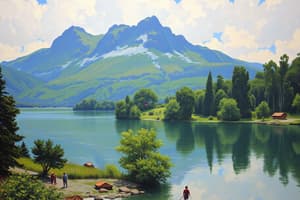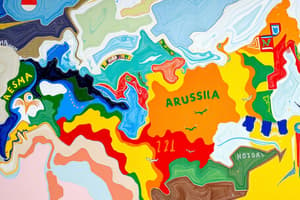Podcast
Questions and Answers
What separates European Russia from Asian Russia?
What separates European Russia from Asian Russia?
- Caucasus Mountains
- Ural Mountains (correct)
- Tundra
- Kamchatka Peninsula
Where do most Russians live?
Where do most Russians live?
North European Plains
What is Siberia known for?
What is Siberia known for?
Abundant natural resources but few inhabitants
What characterizes the Tundra region of Russia?
What characterizes the Tundra region of Russia?
What kind of forest does the Taiga represent?
What kind of forest does the Taiga represent?
What natural geography forms a boundary between Europe and Asia in southwestern Russia?
What natural geography forms a boundary between Europe and Asia in southwestern Russia?
What is the highest point in the Caucasus Mountains?
What is the highest point in the Caucasus Mountains?
What is significant about the Kamchatka Peninsula?
What is significant about the Kamchatka Peninsula?
What is Chernozem?
What is Chernozem?
What unique characteristic does the Caspian Sea have?
What unique characteristic does the Caspian Sea have?
What is the significance of Lake Baikal?
What is the significance of Lake Baikal?
What river drains much of Russia's North European Plain?
What river drains much of Russia's North European Plain?
What are Russia's most abundant mineral resources?
What are Russia's most abundant mineral resources?
What is permafrost?
What is permafrost?
What is the Black Earth Belt?
What is the Black Earth Belt?
What species is Russian caviar harvested from?
What species is Russian caviar harvested from?
What climate region contains the world's largest coniferous forests?
What climate region contains the world's largest coniferous forests?
Describe the Humid Continental Climate of the North European Plain.
Describe the Humid Continental Climate of the North European Plain.
What defines the Steppe region of Russia?
What defines the Steppe region of Russia?
Flashcards are hidden until you start studying
Study Notes
Ural Mountains
- Old mountains separating European Russia from Asian Siberia.
- Serve as a natural boundary dividing two distinct geographic regions.
North European Plains
- Region where the majority of the Russian population resides.
- Milder climates compared to the harsh temperatures of Siberia.
Siberia
- Vast, resource-rich area with a sparse population.
- Known for its extreme cold and extensive natural resources.
Tundra
- Located north of the Arctic Circle, characterized by treeless landscapes.
- Ground remains permanently frozen, supporting only mosses, lichens, algae, and dwarf shrubs.
Taiga
- Expansive belt of dense coniferous forests in Russia.
- Contains one of the largest forested areas in the world, crucial for biodiversity.
Steppe
- Semi-dry grassland featuring rich soil and milder climates than northern Siberia.
- Supports agricultural activities due to its fertile land.
Caucasus
- Mountain range in southwestern Russia, situated between the Black and Caspian Seas.
- Acts as a geographical boundary between Europe and Asia.
Mt Elbrus
- Highest peak in the Caucasus Mountains, standing at 18,510 feet.
- Popular destination for climbers and recognized for its prominence in the region.
Kamchatka Peninsula
- Eastern region of Russia known for its location on the Pacific Ring of Fire.
- Home to over 100 volcanoes, with 23 still active, highlighting its volcanic activity.
Chernozem
- Rich black soil found in Southern European plains.
- Supports large-scale cultivation of crops such as wheat, barley, oats, and rye.
West Siberian Plain
- Largest flatland area globally, characterized by numerous swamps.
- Unique geological features contribute to a diverse ecosystem.
Black Sea
- Warm-water outlet for Russia, providing access to the Mediterranean Sea.
- Vital for the fishing industry, contributing significantly to local economies.
Caspian Sea
- Largest inland body of water in the world, classified as a saltwater lake.
- Lacks an outlet, creating unique ecological and geological conditions.
Lake Baikal
- Deepest freshwater lake globally, with a depth exceeding one mile.
- Estimated to be 20-25 million years old, it holds around 20% of the world's freshwater.
Volga River
- Major river system draining the North European Plain, linking various seas.
- Known as Matushka (Mother Volga), it serves as an essential waterway for transportation.
Siberian Rivers
- Flow towards the Arctic Ocean, often causing flooding due to ice blockages.
- Creates vast swamps, contributing to the unique ecological landscape.
Coal, Oil, Natural Gas
- Abundant mineral resources essential to Russia's economy.
- Key components of the country's export profile.
Permafrost
- Permanently frozen soil covering much of northern Russia.
- Affects drainage and agricultural opportunities in the region.
Black Earth Belt
- Fertile agricultural region stretching from Ukraine to southwestern Russia.
- Crucial for grain and sugar beet production in the country.
Sturgeon
- Fish species from which Russian caviar is harvested.
- Significant in culinary traditions and economy.
Subarctic Climate
- Dominant climate region in Russia with extensive coniferous forests.
- Characterized by long, cold winters and short summers.
Humid Continental Climate
- Experienced across much of the North European Plain.
- Features long, snowy winters with relatively mild temperatures, conducive to human habitation.
Steppe Climate
- Southern climate region in Russia with dry summers and prolonged cold winters.
- Rich soil allows for diverse grasses and plant life, supporting agriculture.
Studying That Suits You
Use AI to generate personalized quizzes and flashcards to suit your learning preferences.




